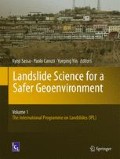Abstract
This paper considers the effects of antecedent precipitation on landslide incidence in the United Kingdom. During 2012–2013 an extraordinary amount of precipitation resulted in an increase in the number of landslides reported in the UK, highlighting the importance of hydrogeological triggering. Slope failures (landslides on engineered slopes) in particular caused widespread disruption to transport services and damage to property. SW England and S Wales were most affected. Easy-to-use and accessible indicators of potential landslide activity are required for planning, preparedness and response and therefore analyses have been carried out to determine whether antecedent effective precipitation can be used as a proxy for landslide incidence. It is shown that for all landslides long-term antecedent precipitation provides an important preparatory factor and that relatively small landslides, such as slope failures, occur within a short period of time following subsequent heavy precipitation. Deep-seated, rotational landslides have a longer response time, as their pathway to instability follows a much more complex hydrogeological response. Statistical analyses of the British Geological Survey landslide database and of weather records have enabled determination of the probability of at least one landslide occurring based on antecedent precipitation signals for SW England and S Wales. This ongoing research is of part of a suite of analyses to provide tools to identify the likelihood of regional landslide occurrence in the United Kingdom.
Access this chapter
Tax calculation will be finalised at checkout
Purchases are for personal use only
References
Baum RL, Godt JW (2009) Early warning of rainfall-induced shallow landslides and debris flows in the USA. Landslides 7:259–272
Booth KA, Diaz Doce D, Harrison M, Wildman G (2010) User guide for the British Geological Survey GeoSure dataset. BGS Open Report OR/10/066
British Geological Survey (2013) Natural hazards partnership. British Geological Survey, Nottingham. http://bgs.ac.uk/research/naturalHazardsPartnership.html
Chambers JE, Hobbs P, Pennington CVL, Jones L, Dixon N, Spriggs M, Haslam E, Meldrum P, Foster C, Jenkins G (2010) Integrated LiDAR, geophysical and geotechnical monitoring of an active inland landslide. EGU 12:5244
Collison A, Wade S, Griffiths J, Dehn M (2000) Modelling the impact of predicted climate change on landslide frequency and magnitude in SE England. Eng Geol 55(3):205–218
Conway BW, Forster A, Northmore KJ, Barclay WJ (1980) South Wales Coalfield landslip survey. Institute of Geological Sciences, Special Surveys Division Engineering Geology Unit, Report EG 80/4
Crozier M (1999) Prediction of rainfall-triggered landslides: a test of the antecedent water status model. Earth Surf Process Landf 24:825–833
Dijkstra TA, Dixon N (2010) Climate change and slope stability in the UK: challenges and approaches. Q J Eng Geol Hydrogeol 43(4):371–385
Dixon N, Brook E (2007) Impact of predicted climate change on landslide reactivation: case study of Mam Tor, UK in Landslides. J Int Consort Landslides 4(2):137–147
Doan S, Vo B-K H, Collier N (2012) An analysis of Twitter messages in the 2011 Tohoku Earthquake. Soc Inform Telecommun Eng 91:58–66
Earle PS, Bowden DC, Guy M (2011) Twitter earthquake detection: earthquake monitoring in a social world. Ann Geophys 54(6):708–715
Evans HM, Pennington CVL, Jordan C, Foster C (2013) Mapping a nation’s landslides: a novel multi-stage methodology. Landslide Sci Pract 1:21–27
Foster C, Harrison M, Reeves HJ (2011) Standards and methods of hazard assessment for mass-movements in Great Britain. J Torrent Avalanche Landslide Rock Eng 166:156–163
Foster C, Pennington CVL, Culshaw MG, Lawrie K (2012) The national landslide database of Great Britain: development, evolution and applications. Environ Earth Sci 66(3):941–953
Gunn DA, Chambers JE, Meldrum PI, Ogilvy RD, Wilkinson PB, Haslam E, Holyoake S, Wragg J (2011) Volumetric monitoring of dynamic moisture distribution in an aged railway embankment. In: 17th Near Surface 2011, Leicester, UK, 12–14 Sept 2011
Gunn DA, Chambers JE, Hobbs PRN, Ford JR, Wilkinson PB, Jenkins GO, Merritt A (2013) Rapid observations to guide the design of systems for long-term monitoring of a complex landslide in the Upper Lias clays of North Yorkshire, UK. Q J Eng Geol Hydrogeol 46(3):323–336
Guzzetti F, Peruccacci S, Rossi M, Stark CP (2008) The rainfall intensity–duration control of shallow landslides and debris flows: an update. Landslides 5:3–17
Minder JR, Roe GH, Montgomery DR (2009) Spatial patterns of rainfall and shallow landslide susceptibility. Water Resour Res 45(4):W04419
Pennington CVL, Harrison AM (2013) 2012 landslide year? Geoscientist Geol Soc London 23(5):10–15
Pennington CVL, Foster C, Chambers J, Jenkins GO (2009) Landslide research at the British Geological Survey: capture, storage and interpretation on a national and site-specific scale. Acta Geol Sin 83(6):801–840
Prokešová R, Medveďová A, Tábořík P, Snopková Z (2013) Towards hydrological triggering mechanisms of large deep-seated landslides. Landslides 10:239–254
Rutter EH, Green S (2011) Quantifying creep behaviour of clay-bearing rocks below the critical stress state for rapid failure: Mam Tor landslide, Derbyshire, England. J Geol Soc 168:359–371
Stollberg B, de Groeve T (2012) The use of social media within the global disaster alert and coordination system (GDACS). In: Proceedings of the 21st international conference companion on World Wide Web, pp 703–706
Venables WN, Ripley BD (2002) Modern applied statistics with S, 4th edn. Springer, New York
Acknowledgments
The authors would like to thank BGS staff: H Reeves, V Banks, H Jordan, D Boon, P Hobbs, M Kirkham & G Jenkins; the Met Office. The authors publish with the permission of the Executive Director of the BGS (NERC).
Author information
Authors and Affiliations
Corresponding author
Editor information
Editors and Affiliations
Rights and permissions
Copyright information
© 2014 Springer International Publishing Switzerland
About this paper
Cite this paper
Pennington, C., Dijkstra, T., Lark, M., Dashwood, C., Harrison, A., Freeborough, K. (2014).
 Antecedent Precipitation as a Potential Proxy for Landslide Incidence in South West United Kingdom.
In: Sassa, K., Canuti, P., Yin, Y. (eds) Landslide Science for a Safer Geoenvironment. Springer, Cham. https://doi.org/10.1007/978-3-319-04999-1_34
Antecedent Precipitation as a Potential Proxy for Landslide Incidence in South West United Kingdom.
In: Sassa, K., Canuti, P., Yin, Y. (eds) Landslide Science for a Safer Geoenvironment. Springer, Cham. https://doi.org/10.1007/978-3-319-04999-1_34
Download citation
DOI: https://doi.org/10.1007/978-3-319-04999-1_34
Published:
Publisher Name: Springer, Cham
Print ISBN: 978-3-319-04998-4
Online ISBN: 978-3-319-04999-1
eBook Packages: Earth and Environmental ScienceEarth and Environmental Science (R0)

